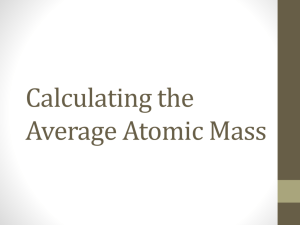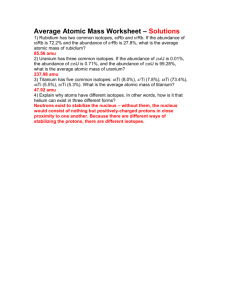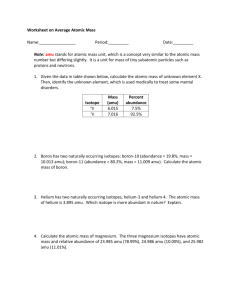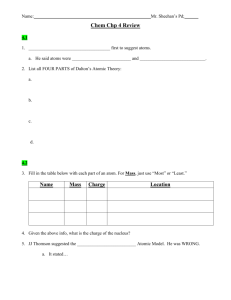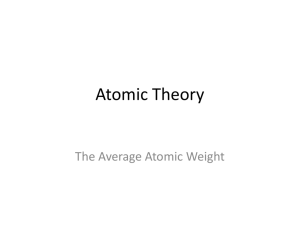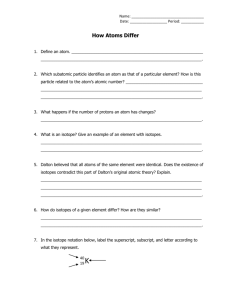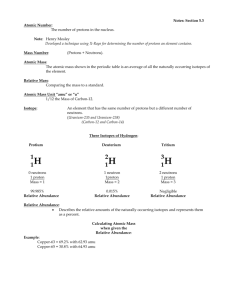Notes
advertisement
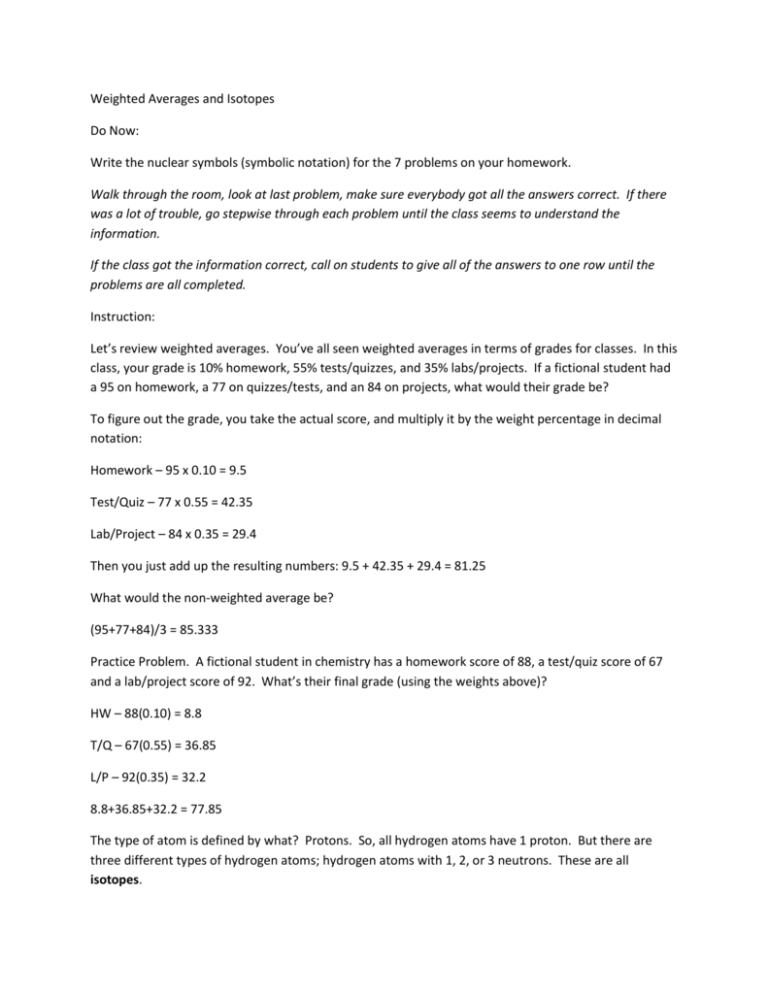
Weighted Averages and Isotopes Do Now: Write the nuclear symbols (symbolic notation) for the 7 problems on your homework. Walk through the room, look at last problem, make sure everybody got all the answers correct. If there was a lot of trouble, go stepwise through each problem until the class seems to understand the information. If the class got the information correct, call on students to give all of the answers to one row until the problems are all completed. Instruction: Let’s review weighted averages. You’ve all seen weighted averages in terms of grades for classes. In this class, your grade is 10% homework, 55% tests/quizzes, and 35% labs/projects. If a fictional student had a 95 on homework, a 77 on quizzes/tests, and an 84 on projects, what would their grade be? To figure out the grade, you take the actual score, and multiply it by the weight percentage in decimal notation: Homework – 95 x 0.10 = 9.5 Test/Quiz – 77 x 0.55 = 42.35 Lab/Project – 84 x 0.35 = 29.4 Then you just add up the resulting numbers: 9.5 + 42.35 + 29.4 = 81.25 What would the non-weighted average be? (95+77+84)/3 = 85.333 Practice Problem. A fictional student in chemistry has a homework score of 88, a test/quiz score of 67 and a lab/project score of 92. What’s their final grade (using the weights above)? HW – 88(0.10) = 8.8 T/Q – 67(0.55) = 36.85 L/P – 92(0.35) = 32.2 8.8+36.85+32.2 = 77.85 The type of atom is defined by what? Protons. So, all hydrogen atoms have 1 proton. But there are three different types of hydrogen atoms; hydrogen atoms with 1, 2, or 3 neutrons. These are all isotopes. Isotopes are atoms that have the same number of protons but different neutrons. Do Isotopes have the same or different atomic number? Do Isotopes have the same or different mass number? The mass of a proton and neutron are essentially the same, and are incredibly small, 1.67 x 10-24 g. The mass of an electron is 1840 times smaller than a proton or neutron, which is negligible in comparison to the protons and neutrons. Since the 1920’s, mass spectrometry has been able to the masses of atoms. The mass of a fluorine atom was found to be 3.1 x 10-23 g. In order to be more practical and useful, carbon-12 was chosen as a reference and this isotope of carbon was defined as having a mass of exactly 12 amu (atomic mass units). Since the 6 protons and 6 neutrons in the carbon-12 atom account for essentially all of it’s mass, and since neutrons and protons have essentially the same mass, the mass of one proton or one neutron is about 1 amu. Take out your agenda and turn to R-15, look up the atomic mass of carbon. What is the atomic mass of carbon? 12.011 Since we just defined carbon-12 as having a mass of 12 amu, why do you think that the atomic mass of carbon is listed as 12.011? In nature, most elements exist as 2 or more stable isotopes. Each isotope of an element has a fixed mass and a natural percent abundance. The atomic mass of an element is the weighted average mass of the atom in a naturally occurring sample of the element. Sample problem: Chlorine has 2 naturally occurring isotopes. Chlorine-35 in 75.77% with a mass of 34.969 amu and chlorine-37 in 24.23% abundance with a mass of 36.966 amu. What’s the atomic mass (weighted average) of chlorine? Chlorine-35 -> 34.969 amu x 0.7577 = 26.4960113 amu Chlorine-37 -> 36.966 x 0.2423 = 8.9568618 amu Atomic mass = 26.4960113 amu + 8.9568618 amu = 35.453 amu Problems for the class: 1) Nitrogen has 2 naturally occurring isotopes: Isotope % abundance Nitrogen-14 99.63 Nitrogen-15 0.37 Nitrogen-14 14.003(0.9963) = 13.9511889 Mass (amu) 14.003 15.000 Nitrogen-15 15.000(0.0037) = 0.0555 What’s the atomic mass (weighted average) of nitrogen? 14.007 amu 2) Oxygen has 3 naturally occurring isotopes: Isotope % abundance Oxygen-16 99.759 Oxygen-17 0.037 Oxygen-18 0.204 Oxygen-16 15.995(0.99759) = 15.95645205 Oxygen-17 16.995(0.00037) = 0.00628815 Oxygen-18 17.999(0.00204) = 0.03671796 Mass (amu) 15.995 16.995 17.999 What’s the atomic mass (weighted average) of oxygen? 15.999 amu 3) Iron has 4 naturally occurring isotopes: Isotope Iron-54 Iron-56 Iron-57 Iron-58 % abundance 5.845 91.754 2.119 0.282 Iron-54 53.939(0.05845) = 3.152793 Mass (amu) 53.940 55.935 56.935 57.933 Iron-56 55.935(0.91754) = 51.3225999 Iron-57 56.935(0.02119) = 1.20645265 Iron-58 57.933(0.00282) = 0.16337106 What’s the atomic mass (weighted average) of iron? 55.845 amu
